6年级上册英语语法
- 格式:docx
- 大小:16.52 KB
- 文档页数:6
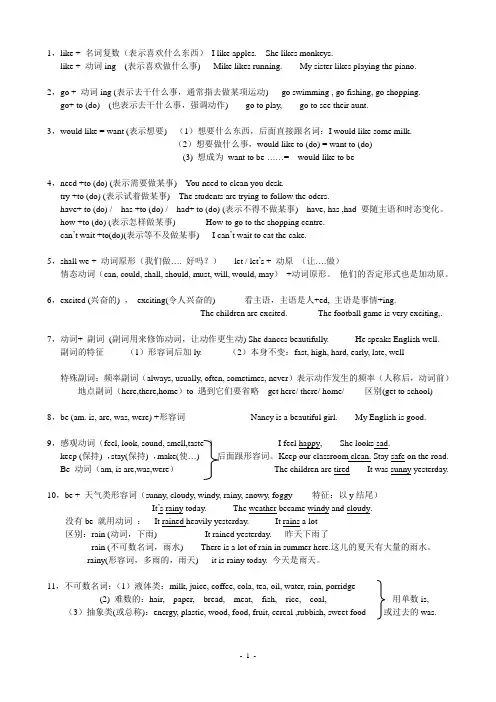
1,like + 名词复数(表示喜欢什么东西)I like apples. She likes monkeys.like + 动词ing (表示喜欢做什么事) Mike likes running. My sister likes playing the piano.2,go + 动词ing (表示去干什么事,通常指去做某项运动) go swimming , go fishing, go shopping.go+ to (do) (也表示去干什么事,强调动作) go to play, go to see their aunt.3,would like = want (表示想要) (1)想要什么东西,后面直接跟名词:I would like some milk.(2)想要做什么事,would like to (do) = want to (do)(3) 想成为want to be ……= would like to be4,need +to (do) (表示需要做某事) You need to clean you desk.try +to (do) (表示试着做某事) The students are trying to follow the oders.have+ to (do) / has +to (do) / had+ to (do) (表示不得不做某事) have, has ,had 要随主语和时态变化。
how +to (do) (表示怎样做某事) How to go to the shopping centre.can’t wait +to(do)(表示等不及做某事) I can’t wait to eat the cake.5,shall we + 动词原形(我们做…. 好吗?)let / let’s + 动原(让….做)情态动词(can, could, shall, should, must, will, would, may)+动词原形。
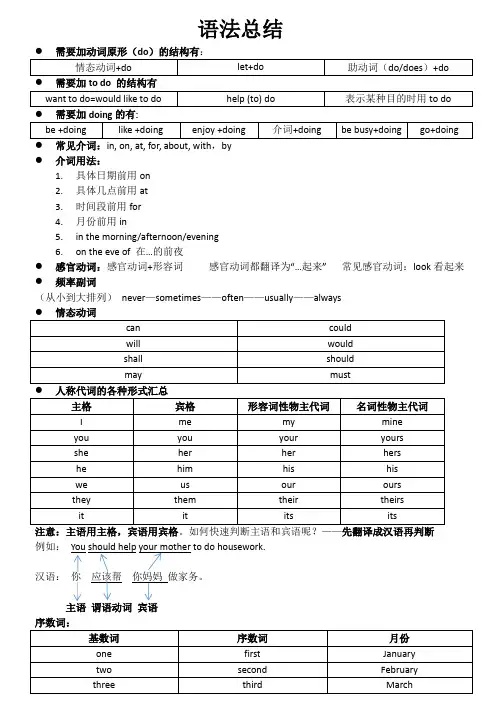
语法总结⚫介词用法:1.具体日期前用on2.具体几点前用at3.时间段前用for4.月份前用in5.in the morning/afternoon/evening6.on the eve of 在…的前夜⚫感官动词:感官动词+形容词感官动词都翻译为“…起来” 常见感官动词:look看起来⚫频率副词(从小到大排列)never—sometimes——often——usually——always注意:主语用主格,宾语用宾格。
如何快速判断主语和宾语呢?——先翻译成汉语再判断例如:汉语:你主语序数词:⚫祈使句⚫现在进行时1.表示现在正在发生2.look,listen,now是现在进行时的标志3.基本结构:be+doing⚫一般现在时1.表示经常性,习惯性的动作2.频率副词出现,是一般现在时的标志3.一般现在时中,动词只有两种形式:原形/三单⚫句型题做题步骤先判断句子中的动词是be动词/情态动词/实义动词哪一种如何判断——排除法(be动词3个,情态动词7个,上面已写。
如果都不是,则是实意动词)否定句口诀:否定句,也不难,be后情后not添实意动词找帮手,don’t, doesn’t动前添谓语动词要还原一般疑问句口诀:有情提情,有be提be有实用助,有助还原注意:几个固定的特殊疑问句需要记住1. 问价格How much 开头 如:How much is it? / How much are they?2. 问数量 How many 开头 如:How many English lessons do you have in a week? ⚫ 三单的概念“三单”即“第三人称单数”第三人称单数包含两个特征:第三人称+单数如何快速判断第三人称单数——排除法 一个词既不是“你/你们/我/我们”,也不是复数,那么就是第三人称单数 特殊记忆:every 出现就是三单 “三单”后的动词也要变“三单”,有以下三种变法:1. 加s —比如like -likes2. 加es —比如watch -watches3.不规则变化—比如have -has 注意:单词以下列字母结尾需要加es ——x, ch, sh, o, y (把y 改i 加es ),f/fe (把f/fe 改v加He doesn’t like bananas.es)⚫感叹句结构:How+形+主+谓(动)!⚫There be句型就近原则:谁跟be离得近,be就跟谁保持一致⚫其他语法总结:1.be +形容词+to do比如:be happy to do /be difficult to do/ be pleased to do…2.go home / go back home home前不用to3.do some+doing 比如:do some reading4.by+方式比如:by email5.How about = What about6.learn from 向….学习7.have a look看一看look at…看一看…(后面接要看的东西)8.look here/there 看这里/那里here/there前不加to9.interesting修饰物,interested修饰人10.be interested in… 对…感兴趣(由于in是介词,因此后面动词要用doing形式)11.photo复数photos12.take care of 照顾13.Here is/are ….for…. 这是给….的…..14.invite….to…. / give….to…. / come to / celebrate ….with….15.What shape (of cake)would you like? 答语中一定有shape16.Show +某人’s/形物代+ love +for… 为…展示…的爱比如:show my love for mum17.jelly, ice cream, candy 不可数,不能变复数18.Shall we+ do19. a piece of / some pieces of20.first首先/ then/after that/next然后/ finally/at last最后21.have a holiday/ have summer holidays/have winter holidays 放假/放暑假/放寒假22.be called 被称为be founded 被建立23.at home在家24.make+人/物+形容词使某人/某物变得… 比如:make the country greener25.all over the world 全世界26.share…with… 和…分享…27.School is out. 学校放假。
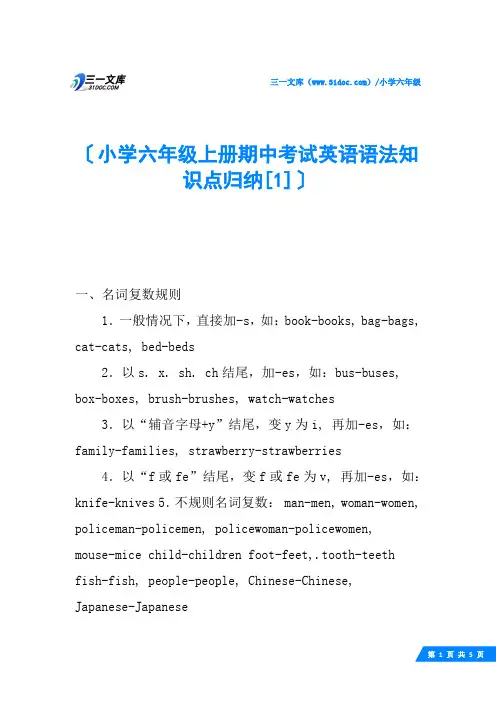
三一文库()/小学六年级〔小学六年级上册期中考试英语语法知识点归纳[1]〕一、名词复数规则1.一般情况下,直接加-s,如:book-books, bag-bags, cat-cats, bed-beds2.以s. x. sh. ch结尾,加-es,如:bus-buses, box-boxes, brush-brushes, watch-watches3.以“辅音字母+y”结尾,变y为i, 再加-es,如:family-families, strawberry-strawberries4.以“f或fe”结尾,变f或fe为v, 再加-es,如:knife-knives 5.不规则名词复数: man-men, woman-women, policeman-policemen, policewoman-policewomen,mouse-mice child-children foot-feet,.tooth-teethfish-fish, people-people, Chinese-Chinese,Japanese-Japanese二、一般现在时1.一般现在时表示经常或习惯性的动作,也可表示现在的状态或主语具备的性格和能力。
2.一般现在时中,没有be动词和情态动词,主语为第三人称单数的肯定句,动词要按规则加上s,主语是非第三人称单数的肯定句,动词用原形。
3.在一般现在时中,句中有be动词或情态动词时,否定句在be动词和情态动词后加not,一般疑问句将be动词或情态动词放在句首。
4.在一般现在时中,句中没有be动词或情态动词时,主语为第三人称单数的否定句在动词前加does+not (doesn‘t),一般疑问句在句首加does,句子中原有动词用原形;主语为非第三人称单数,否定句用do+not (don’t),一般疑问句在句首加do,句子中动词用原形。
动词+s的变化规则1.一般情况下,直接加-s,如:cook-cooks, milk-milks2 .以s. x. sh. ch. o结尾,加-es,如:guess-guesses, wash-washes, watch-watches, go-goes3.以“辅音字母+y”结尾,变y为i, 再加-es,如:study-studies 三、现在进行时1.现在进行时表示现在正在进行或发生的动作,也可表示当前一段时间内的活动或现阶段正在进行的动作。

小学六年级上册英语语法HEN system office room 【HEN16H-HENS2AHENS8Q8-HENH1688】小学六年级上册英语语法What 事件 when 事件 where地点 who谁 why为什么 how 怎样wh疑问词和陈述句是降调。
E--a连 at前后都连读。
单数is复数are,is跟着他她它。
一般情况下加ing:do-doing sing-singing study-studying comfort-comforting以不发音的e、ue结尾的动词去e加ing:dance-dancing like-liking write-writing make-making take-taking以重读闭音节尾的动词且末尾只有一个辅音字母。
最后一个字母不是x的动词应双写最后的字母,再加ing:run-running cut-cutting swim-swimming以ue结尾的动词应变ie为y加ing:die-dying lie-lying以ic结尾的动词应加king:picnic-picnicing traffic-trafficing人称变化5. Excuse(me√ / my / I).6. Are(your√ / you)Miss Li?7. (I√/ My)am Ben.8. (She √/ Her)is my sister.9. Fine , thank (your / you√).10. How old is (he / his√)二、用所给代词的正确形式填空。
1. These are __his____ ( he ) brothers.2. That is ___her____( she ) sister.3. Lily is ___luly’s____ ( Lucy ) sister.4. Tom, this is __mine___ ( me ) cousin, Mary.5. Now ______her parent’s_______(her parent) are in America.6. Those _____child_____ ( child ) are __my___ ( I ) father’s students.7. Do you know ____it is__ ( it ) name?8. Mike and Tom _____be_____ ( be ) friends.9. Thanks for helping ___me_____( I ).10. ___Ann’s___(Ann安)mother is ___we___(we) teacher.三、单项选择。
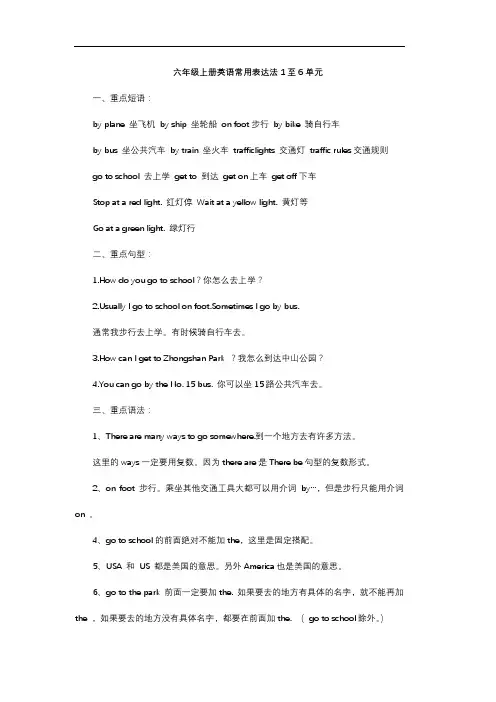
六年级上册英语常用表达法1至6单元一、重点短语:by plane 坐飞机by ship 坐轮船on foot步行by bike 骑自行车by bus 坐公共汽车by train 坐火车trafficlights 交通灯traffic rules交通规则go to school 去上学get to 到达get on上车get off下车Stop at a red light. 红灯停Wait at a yellow light. 黄灯等Go at a green light. 绿灯行二、重点句型:1.How do you go to school?你怎么去上学?ually I go to school on foot.Sometimes I go by bus.通常我步行去上学。
有时候骑自行车去。
3.How can I get to Zhongshan Park ?我怎么到达中山公园?4.You can go by the No. 15 bus. 你可以坐15路公共汽车去。
三、重点语法:1、There are many ways to go somewhere.到一个地方去有许多方法。
这里的ways一定要用复数。
因为there are是There be句型的复数形式。
2、on foot 步行。
乘坐其他交通工具大都可以用介词by…,但是步行只能用介词on 。
4、go to school的前面绝对不能加the,这里是固定搭配。
5、USA 和US 都是美国的意思。
另外America也是美国的意思。
6、go to the park 前面一定要加the. 如果要去的地方有具体的名字,就不能再加the ,如果要去的地方没有具体名字,都要在前面加the. (go to school除外。
)7、How do you go to…?你怎样到达某个地方?如果要问的是第三人称单数,则要用:How does he/she…go to …?。
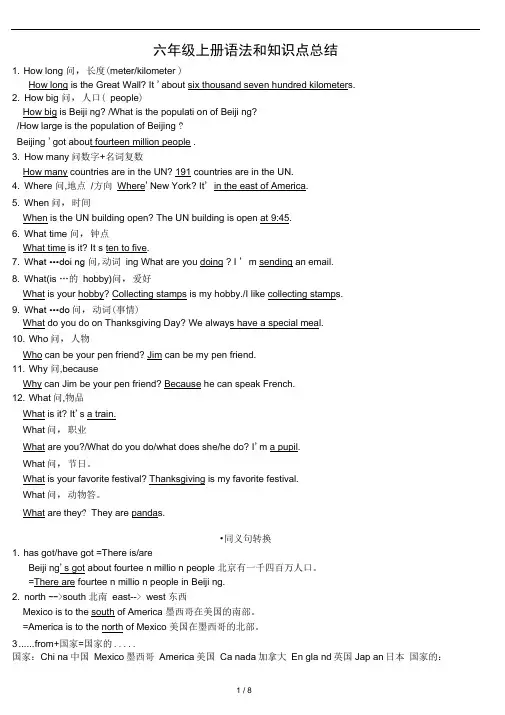
六年级上册语法和知识点总结1. How long 问,长度(meter/kilometer )How long is the Great Wall? It 'about six thousand seven hundred kilometers.2. How big 问,人口( people)How big is Beiji ng? /What is the populati on of Beiji ng?/How large is the population of Beijing ?Beijing 'got about fourteen million people .3. How many问数字+名词复数How many countries are in the UN? 191 countries are in the UN.4. Where 问,地点/方向Where'New York? It' in the east of America.5. When问,时间When is the UN building open? The UN building is open at 9:45.6. What time 问,钟点What time is it? It s ten to five.7. What •••doi ng 问,动词ing What are you doing ? I ' m sending an email.8. What(is …的hobby)问,爱好What is your hobby? Collecting stamps is my hobby./I like collecting stamps.9. What •••do问,动词(事情)What do you do on Thanksgiving Day? We always have a special meal.10. Who问,人物Who can be your pen friend? Jim can be my pen friend.11. Why 问,becauseWhy can Jim be your pen friend? Because he can speak French.12. What问,物品What is it? It's a train.What问,职业What are you?/What do you do/what does she/he do? I'm a pupil.What问,节日。
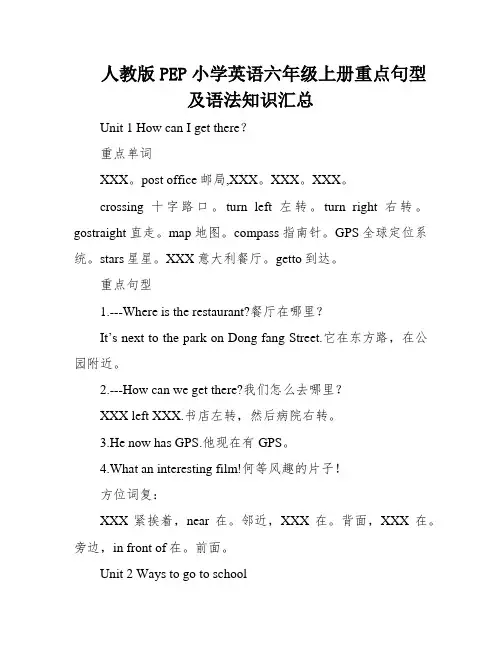
人教版PEP小学英语六年级上册重点句型及语法知识汇总Unit 1 How can I get there?重点单词XXX。
post office邮局,XXX。
XXX。
XXX。
crossing十字路口。
turn left左转。
turn right右转。
gostraight直走。
map地图。
compass指南针。
GPS全球定位系统。
stars星星。
XXX意大利餐厅。
getto到达。
重点句型1.---Where is the restaurant?餐厅在哪里?It’s next to the park on Dong fang Street.它在东方路,在公园附近。
2.---How can we get there?我们怎么去哪里?XXX left XXX.书店左转,然后病院右转。
3.He now has GPS.他现在有GPS。
4.What an interesting film!何等风趣的片子!方位词复:XXX紧挨着,near在。
邻近,XXX在。
背面,XXX在。
旁边,in front of在。
前面。
Unit 2 Ways to go to school重点单词on foot走路。
by bike骑车。
by bus乘公交。
by train乘火车。
XXX乘地铁。
by ship搭船。
by XXX乘飞机。
slow down 慢下来。
XXX交通灯。
traffic rules交通划定规矩。
go/come to school上学。
by sled坐雪橇。
byferry坐轮渡。
pay n to留意。
traffic lights交通灯。
and wait at a red light红灯停等一等。
slow downand。
at a yellow light黄灯减速并停下。
Go XXX。
重点句型1.---How do you come to school?你怎么上学?----Usually。
I come on foot.通常我走路来的。
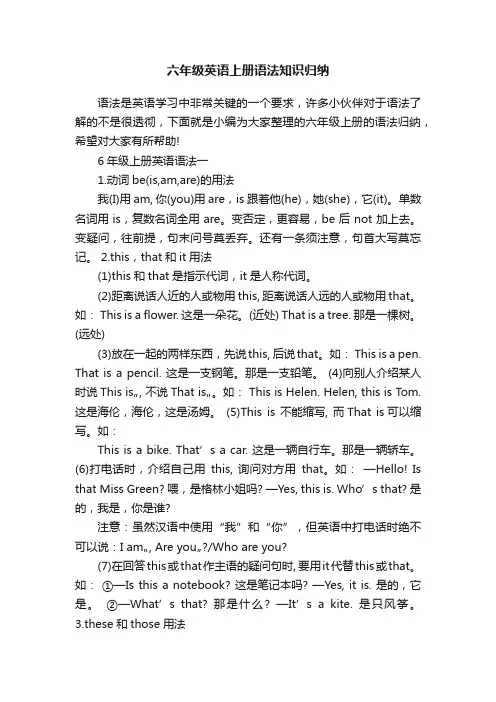
六年级英语上册语法知识归纳语法是英语学习中非常关键的一个要求,许多小伙伴对于语法了解的不是很透彻,下面就是小编为大家整理的六年级上册的语法归纳,希望对大家有所帮助!6年级上册英语语法一1.动词be(is,am,are)的用法我(I)用am, 你(you)用are,is跟着他(he),她(she),它(it)。
单数名词用is,复数名词全用are。
变否定,更容易,be后not加上去。
变疑问,往前提,句末问号莫丢弃。
还有一条须注意,句首大写莫忘记。
2.this,that和it用法(1)this和that是指示代词,it是人称代词。
(2)距离说话人近的人或物用this, 距离说话人远的人或物用that。
如: This is a flower. 这是一朵花。
(近处) That is a tree. 那是一棵树。
(远处)(3)放在一起的两样东西,先说this, 后说that。
如: This is a pen. That is a pencil. 这是一支钢笔。
那是一支铅笔。
(4)向别人介绍某人时说This is…, 不说That is…。
如: This is Helen. Helen, this is Tom. 这是海伦,海伦,这是汤姆。
(5)This is 不能缩写, 而That is可以缩写。
如:This is a bike. That’s a car. 这是一辆自行车。
那是一辆轿车。
(6)打电话时,介绍自己用this, 询问对方用that。
如:—Hello! Is that Miss Green? 喂,是格林小姐吗? —Yes, this is. Wh o’s that? 是的,我是,你是谁?注意:虽然汉语中使用“我”和“你”,但英语中打电话时绝不可以说:I am…, Are you…?/Who are you?(7)在回答this或that作主语的疑问句时, 要用it代替this或that。
如:①—Is this a notebook? 这是笔记本吗? —Yes, it is. 是的,它是。
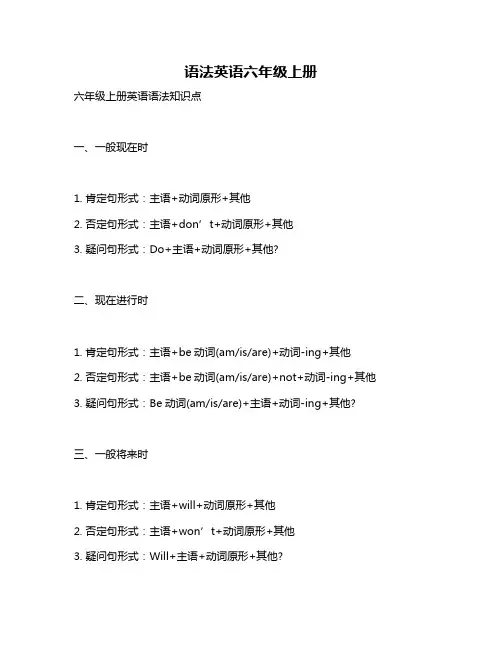
语法英语六年级上册
六年级上册英语语法知识点
一、一般现在时
1. 肯定句形式:主语+动词原形+其他
2. 否定句形式:主语+don’t+动词原形+其他
3. 疑问句形式:Do+主语+动词原形+其他?
二、现在进行时
1. 肯定句形式:主语+be动词(am/is/are)+动词-ing+其他
2. 否定句形式:主语+be动词(am/is/are)+not+动词-ing+其他
3. 疑问句形式:Be动词(am/is/are)+主语+动词-ing+其他?
三、一般将来时
1. 肯定句形式:主语+will+动词原形+其他
2. 否定句形式:主语+won’t+动词原形+其他
3. 疑问句形式:Will+主语+动词原形+其他?
四、一般过去时
1. 肯定句形式:主语+动词过去式+其他
2. 否定句形式:主语+didn’t+动词原形+其他
3. 疑问句形式:Did+主语+动词原形+其他?。
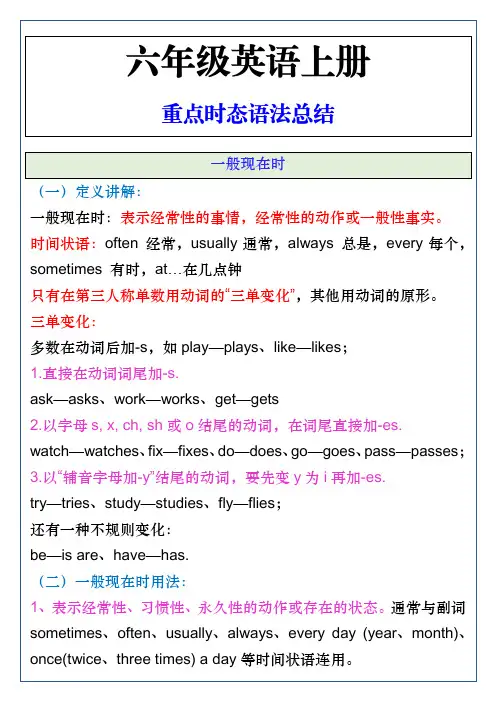
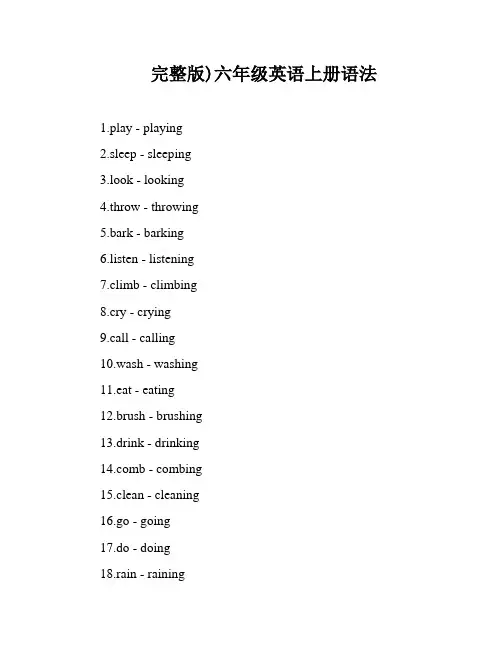
完整版)六年级英语上册语法1.play - playing2.sleep - sleeping3.look - looking4.throw - throwing5.bark - barking6.listen - listening7.climb - climbing8.cry - crying9.call - calling10.wash - washing11.eat - eating12.brush - brushing13.drink - drinkingb - combing15.clean - cleaning16.go - going17.do - doing18.rain - raining19.XXX - talking20.grow - growing21.open - opening22.sing - singing23.walk - walking二、改写:1.The children are XXX.2.The children are not playing in the park at the moment.3.Are the children playing in the park right now。
Yes。
they are。
/ No。
they are not.4.What are the children doing now?三、时间标志:Some examples of time markers for the present continuous tense include "now" and "look" or "listen" at the beginning of a sentence.Are they doing housework?They are not doing housework.2.He is XXX(改成现在进行时)XXX.3.XXX(改成否定句)She does not like to swim in the pool.4.We will go to the XXX(改成一般疑问句)Will we go to the park tomorrow?5.I have XXX(改成否定句和过去式)I have not XXX.I XXX.2.当主语为第三人称单数时,助动词为does肯定句:主语+动词原形(+其它)。
Unit 4 I have pen pal1、动词变为动名词的规则:动词变为动名词,即是动词加ing。
一般要遵循以下三条规则:(1)一般情况下,在动词的后面直接加ing。
如:play—playing read—reading do—doing go—going(2)以不发音的字母e结尾的动词,要去掉不发音的字母e,再加ing。
如:write—writing ride—riding make—making dance—dancing(3)以单元音加单辅音结尾的重读闭音节,要双写最后一个辅音字母,再加ing。
如:run—running swim—swimming put—putting sit—sitting2、关于第三人称单数:动词变为第三人称单数形式的规则:(1)在一个句子中,如果主语人称既不是你,也不是我,而是另外的一个人,这时的人称叫做第三人称单数。
(2)在第三人称单词的句子中,动词要使用第三人称单词形式。
(3)动词变为第三人称单数形式,要遵循以下规则:①一般情况下,在动词的后面直接加s。
如:read--reads make—makes write—writes②以字母s, x, o , sh , ch结尾的动词,在词尾加es。
如:do—does wash—washes teach—teaches go—goes pass—passes③以y结尾的动词分为两个情况,以元音字母加y结尾的动词,在词尾直接加s。
如:play—plays buy--buys以辅音字母加y结尾的动词,要把y变为i,再加es.如:study--studies④以f , fe结尾的名词,先把f,fe变为v,再加-es.⑤特殊变化:have--has(4)在一个第三人称单数的句子中,只要句子中出现了does或者其否定形式doesn’t.该句子中的其他动词就要使用原形。
(5)第三人称单数的肯定句在变为否定句时,在动词的前面加doesn’t. 动词恢复原形。
1. 一般现在时:句子中的主语用第三人称单数时,动词需加s或es。
如:She likes ice cream.2. 一般过去时:句子中的主语要用过去式动词。
如:He played football yesterday.3. 现在进行时:由“be + 动词的ing形式”构成,表示当前正在进行的动作。
如:They are watching TV now.4. 一般将来时:表示将来发生的动作或存在的状态。
如:I will go to the park tomorrow.5. 祈使句:用来表达请求、命令、劝告等,一般省略主语。
如:Do your homework now.6. 定义性从句:用来对主句中的名词进行解释或给出相关信息。
如:The book that is on the table is mine.7. 状语从句:用来表示时间、地点、原因、条件等,常用连词如when、where、because、if等引导。
如:I will go to bed when Ifinish my homework.8. 三单形式:动词的第三人称单数形式,一般在动词原形后加s、es。
如:He reads books every day.9. 比较级与最高级:用于比较两个事物的大小、程度等。
比较级在两个事物之间进行比较,最高级表示在三个以上的事物之间进行比较。
如:This book is longer than that one. This is the tallest buildingin the city.10. 反意疑问句:附在陈述句结尾,表示征求对方的意见或肯定。
一般与陈述句的人称、时态保持一致。
如:You like swimming, don't you?11. 疑问句:用于询问信息,一般由助动词、系动词或疑问词引导。
如:Can you swim? What is your name?12. There be句型:表示处存在人或物的状态。
六年级上册英语重点句型语法总结六年级上册涉及的重要语法知识主要有6种:to be句型、there be句型、一般现在时句型、现在进行时句型、一般过去时句型、情态动词can引导的型、be going to句型等。
现以5-8册书为例,简要总结如下:[一] to be句型:用于介绍个人情况如姓名、健康状况、身份、国籍、家庭成员、朋友、职业等,描述地点、颜色、四季、日期、星期几等,该句型广泛分布于各册教材中,其中5—7册的句型主要有:1. Who’s your English teacher?Mr. Carter.2. What’s he like?He’s tall and strong.3. Is she quiet? No, she isn’t.She is very active.4. Is she strict? Yes, she is, but she’s very kind.5. What day is it today? It’s Wednesday.6. What’s your favourite fruit/food…?7. They’re sweet/ sour/ salty/ healthy/…8. When is your birthday? It’s in May.9. My birthday is in June. Uncle Bill’s birthday is in June, too.10. Is her birthday in June? Yes, it is.11. What’s the date?12.This is Zhang Peng.13. Where is the cinema, please? It’s next to the hospital.[二] there be句型:表示存在,即:“某处有某物”或“某时有某事”。
句型基本结构为:There is+ 可数名词单数或不可数名词+时间或地点。
小学英语六年级上册语法am 用于第一人称:我(I)一、be is 用于第三人称单数形式:他/她/它(he/she/it)are 用于第二人称(你,你们you)和复数(我们we,他们/它们they) 举例:I am a student.He is a student./She is a student.You are a student./They are students./We are student.do 用于第一、二人称,及复数二、dodoes 用于第三人称单数形式举例:I do my homework./You do homework.He does his homework./She does homework.Do you get up early everyday? Does she get up early everyday?Do you usually have breakfast? Does she usually have breakfast?Do you want to be a teacher? Does he want to be a teacher?三、when, where, who, what, how引导特殊疑问句举例:When do you go home? 你什么时候回家?Where are we going? 我们去哪儿?Who is that man? 那个人是谁?What do you want to buy? 你想买什么?How do you go there? 你怎么去?四、主格与宾格人称代我我们你你们他她它他们词主格I we you you he she it they宾格me us you you his her it them物主代my our your your his her its their词五、第三人称:动词原形+s或动词原形+es.举例:do-does, look-looks, buy-buys, like-likesI like dogs. / She likes dogs.六、介词:in,on, at, after, to, from早、午、晚要用in例:in the morning 在早上on Monday.in the afternoon 在下午on Tuesday.in the evening 在晚上on Thursday.in the day 在白天在星期几用on.at 午、夜、点与分例: at noon 在中午at night 在夜间to 表示寄信人,at six o"clock 在6点钟from表示收信人。
六年级上册英语语法知识点汉语和英语两种语言所代表的思维方式有所不同,汉语更加倾向于环式思维,注重抽象和整体认识;英语倾向于直线思维,注重于归纳推理。
下面就是给大家带来的六年级上册英语语法知识点,希望能帮助到大家!六年级上册英语语法知识点1. 现在进行时表示正在发生的事情或进行的动作,常与now,listen,look等词连用,结构是主语+be动词(am, is, are)+动词ing.如:It is raining now.外面正在下雨It is six o’clock now.现在6点了My parents are reading newspapers in the sitting room.我父母正在客厅看报纸Look! The children are having a running race now.看!孩子们正在赛跑问句将be动词移前,否定句在be动词后+not.2. 一般现在时表示经常反复发生的事情或动作,常与often, usually, sometimes, always, every day(week year…) on Sundays等词连用。
结构是主语+动词原形;当主语为第三人称单数即he,she, it, Tom, my mother, the boy等词时,动词后加s或es.如:We have an English lesson every day.我们每天都要上英语课Do the boys run faster than the girls? Yes, they do.男孩比女孩跑的快吗?是的问句借助于do, does否定句借助于don’t, doesn’t,后面动词一定要还原。
3. 一般过去时表示发生在过去的事情或存在的状态,常与just now; a moment ago; … ago; yesterday; last ( week; month; year; Monday; weekend); this morning等词连用。
6年级上册英语语法
1.动词be(is,am,are)的用法
我(I)用am, 你(you)用are,is跟着他(he),她(she),它(it)。
单数名词用is,复数名词全用are。
变否定,更容易,be后not加上去。
变疑问,往前提,句末问号莫丢弃。
还有一条须注意,句首大写莫忘记。
2.this,that和it用法
(1)this和that是指示代词,it是人称代词。
(2)距离说话人近的人或物用this, 距离说话人远的人或物用that。
如:
This is a flower. 这是一朵花。
(近处)
That is a tree. 那是一棵树。
(远处)
(3)放在一起的两样东西,先说this, 后说that。
如:
This is a pen. That is a pencil. 这是一支钢笔。
那是一支铅笔。
(4)向别人介绍某人时说This is…, 不说That is…。
如:
This is Helen. Helen, this is Tom. 这是海伦,海伦,这是汤姆。
(5)This is 不能缩写, 而That is可以缩写。
如:
This is a bike. That’s a car. 这是一辆自行车。
那是一辆轿车。
(6)打电话时,介绍自己用this, 询问对方用that。
如:
—Hello! Is that Miss Green? 喂,是格林小姐吗?
—Yes, this is. Who’s that? 是的,我是,你是谁?
注意:虽然汉语中使用“我”和“你”,但英语中打电话时绝不可以说:I am…, Are you…?/Who are you?
(7)在回答this或that作主语的疑问句时, 要用it代替this或that。
如:
①—Is this a notebook? 这是笔记本吗?
—Yes, it is. 是的,它是。
②—What’s that? 那是什么?
—It’s a kite. 是只风筝。
3.these和those用法
this, that, these和those是指示代词,these是this的复数形式,指时间,距离较近的或下面要提到的人或事;those是that的复数形式,指时间、距离较远或前面已经提到过的人或事物。
①This is my bed. That is Lily’s bed. 这是我的床。
那是莉莉的床。
②These pictures are good. 那些画很好。
③Are those apple trees? 那些是苹果树吗?
在回答主语是these或those的疑问句时,通常用they代替these或those以避免重复。
如:
④Are these/those your apples? 这些(那些)是你的苹果吗?
Yes, they are. 是的,他们是。
4.名词+’s所有格
单数名词后直接加“’s ”:
Jim’s coat 吉姆的外套Jeff’s mother杰夫的妈妈
以s结尾的复数名词,只加“’”
Teachers’Day教师节the twins’books双胞胎的书
不以s结尾的不规则的名词复数,加“’s ”
Children’s Day 儿童节men’s shoes男式鞋
表示两者共同拥有时,只在最后一个名词后加’s
Lucy and Lily’s mother 露茜和莉莉的妈妈(共同的妈妈,一个妈妈)
表示两者各自拥有时,要在每个名词后加’s
Lucy’s and Kate’s rooms 露茜和凯特的房间(各自的房间,两间房子)5.There be句型
(1)There be句型主要用以表达“某处(某时)有某人(某物)。
”其基本结构为“There be+某物(某人)+某地(某时)”其中there是引导词,没有词义;主语是be后面的名词,be是谓语动词,在一般现在时中be只用is和are两种形式。
下面这首歌诀可帮你巧记there be句型结构:
There be放句首,主语跟在后。
地、时放句末,强调置前头。
如:
There is a book on the desk.
有时为了强调地点,也可把介词短语放在句首。
如:
On the desk there is a book.
(2)There be句型中的be动词如何确定呢?请先看看下面这首歌诀:
Be动词,有三个,am,is还有are。
“There be”真特别,不留am只留俩,那就是is还有are。
要用is还是are,须看其后的名词是单数还是复数。
若是单数或不可数名词用is,否则就用are。
如:
①There is a tree behind the house.
②There is some water(水)in the bottle(瓶子).
③There are some pears in the box.
(3)注意:如果“be”后的主语是由and连接的两个或两个以上的名词,那么be
的形式要遵循“远亲不如近邻”的原则。
也就是说,“be”的形式是由与它最近的那个名词来确定的。
若那个名词是单数或不可数名词要用is,是复数就用are。
如:
①There is a book and some pens on the floor.
②There are some pens and a book on the floor.
6.like一词的用法
like用作及物动词,译为“喜欢”。
(1)后接名词或代词,表示喜欢某人或某物。
如:
I like the baby very much. 我非常喜欢这个小孩。
(2)后接动名词(v. -ing),表示“喜欢做某事”,着重于习惯、爱好。
如:
Tom likes playing football. 汤姆喜欢踢足球。
(3)后接动词不定式(to do ),表示“偶尔地喜欢做某事”,着重于某次具体的行为。
如:
I like reading, but I like to watch TV this evening. 我喜欢读书,但我今晚想看电视。
7.句子单数变复数,注意以下五要素
(1)主格人称代词要变成相应的复数主格人称代词,即I→we, you→you,she,he,it→they。
如:She is a girl. →They are girls.
(2)am,is要变为are。
如:
I’m a student. →We are students.
(3)不定冠词a,an要去掉。
如:
He is a boy. →They are boys.
(4)普通单数名词要变为复数形式。
如:
It is an apple. →They are apples.
(5)指示代词this,that要变为these,those。
如:
This is a box. →These are boxes.
8.英语日期的表示法
英语中月份和星期名称都是专有名词,它们的首字母必须大写,并且前面无需用冠词。
用英语表示日期,其顺序为月+日+年,日和年之间需用逗号隔开。
如:August 2nd,2003(2003年8月2日)。
也可以用日+月+年来表示。
如:10th May,2003(2003年5月10日)英语日期前介词的使用:若指在哪一年或哪一月,则用介词in,若具体到某一天,则需用介词on。
9.时间的表达法
(1) 直读式,即直接读出时间数字
7: 05 seven five 8:16 eight sixteen
(2) 过、差式,即几点差几分,几点过几分。
(以30分为分界线)
1:25 twenty-five past one 2:30 half past two
3:43 seventeen to four 4:38 twenty-two to five
(3)12小时制
6:00 a.m. 上午6点8:20 p.m. 下午8点20分
(4)24小时制
13:00 13点钟22:15 22点15分
(5)15分可用quarter
4:15 a quarter past four 5:45 a quarter to six
(6)时间前通常用at.
at 5 o’clock at 7:30 p.m.
10. want用法
(1)想干什么用want to do sth
They want to join the sports club. 他们想加入运动俱乐部。
(2)第三人称单数作主语,want要作变化
①He wants to play basketball.
②Li Xia wants to play the piano.
(3)变疑问句,否定句要借助助动词do或does.
①-Do you want to play soccer ball ? -Yes , I do . / No , I don’t.
②-Does he want to go home by bus ? -Yes , he does . / No , he doesn’t。